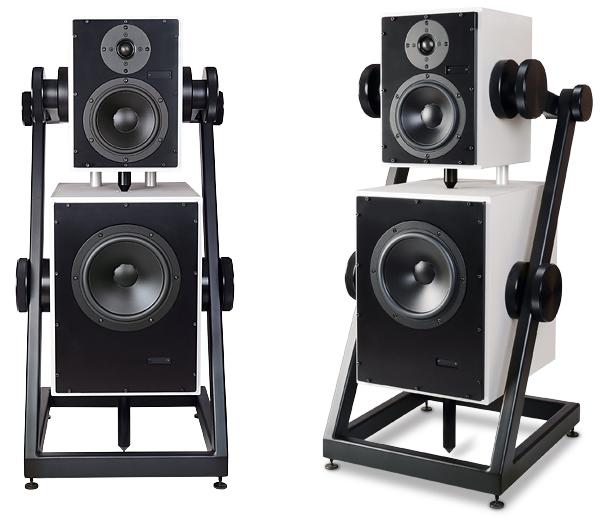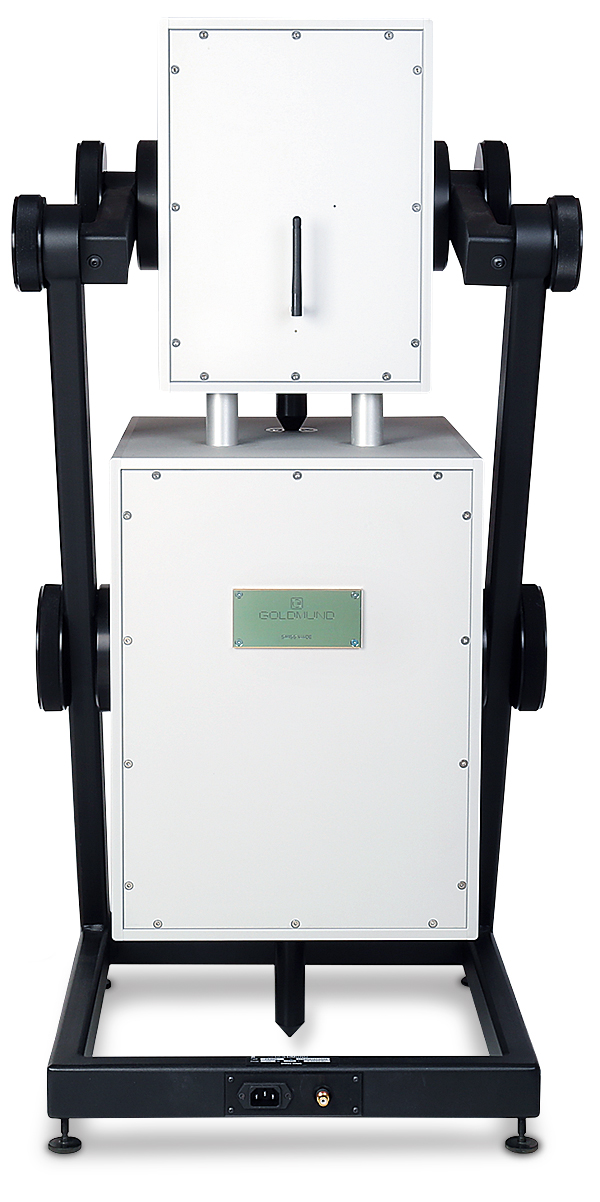Goldmund Mimesis 15/Prana Active Loudspeaker

 There certainly aren't many speakers that look like them, but these baby models – yes, really – in the Swiss brand's wireless active range combine style with all-alloy substance
There certainly aren't many speakers that look like them, but these baby models – yes, really – in the Swiss brand's wireless active range combine style with all-alloy substance
When the entry-level model in a speaker range costs £70,000 a pair, and weighs no less than 80kg – that's each speaker – you'd rightly assume you're in very serious high-end territory. And yes, imposing though the Prana speaker looks, its two aluminium enclosures mounted on a hefty 'Z-frame' and the whole enterprise standing some 99cm tall, this is the baby of this particular range. Above it sit the Satya speakers, 1.23m tall, 140kg apiece and £110,000 a pair, while the flagship is the 1.47m tall, 180kg-a-pop Samadhi, yours for a nice neat £200k a pair...
All three speakers clearly have much of the DNA of Goldmund's 1987 Apologue reference speaker, designed by Italian artist Claudio Rotta Loria on the same 'multiple enclosures on a Z-frame' principle – it's just that the Apologue used five enclosures and was a passive design, before the Anniversary edition 35 years later became active and wireless. While the Apologue name derived from Greek for the truth, the current lineup instead draws on Sanskrit, Prana meaning 'the universal sea of energy that infuses and vitalises all matter', Satya 'truth' and Samadhi 'the climax of all spiritual and intellectual activity'.
Chunk Of Change
All three speakers are the product of Goldmund's in-house modelling software, previewed in a paper at the 2007 AES Convention in Austria. The firm's engineers proposed a DSP-based solution to tackle the phase and group delay distortions associated with the port, drivers and crossover used in a two-way, reflex-loaded loudspeaker. Maintaining a flat amplitude response was also key to the project.

Using Matlab software, Goldmund's custom IIR (Infinite Impulse Response) filter corrected the crossover phase and group delay distortions but only proved stable if the input signal was first divided into chunks and 'reversed' in time using a LIFO (Last in/First Out) buffer. After processing, the data chunks were switched back into correct time and reassembled. Dubbed the 'Leonardo Project', this computer modelling was extended to include almost every aspect of loudspeaker design, including cabinet diffraction effects, and was first implemented in the Epilogue range and for the Metis speaker and sub.
Theory To Practice
'The comparisons between measurements and calculations were so good', reported Goldmund's Head of Acoustics, Dr Véronique Adam, 'that we decided to give up the necessity of any measurements for the loudspeaker systems developed after this validation'.
The latest Leonardo 2 version of this time alignment correction algorithm, with digital crossovers, gains and delays, is incorporated in the active Prana speakers we have here.
And that's where we enter the world of Goldmund speaker design – yes, the same Goldmund responsible for the celebrated Reference turntable of 1983. But in this new, computer-modelled world the Pranas, as well as looking as they do, also seem to break a lot of rules along the way. For example, whereas just about every other speaker on the market employs some kind of shaping to its cabinet to control diffraction, dispersion and internal reflections, the Prana boasts two resolutely rectangular alloy boxes.
The microbead blasted, anodised finish is truly superb while damping is seemingly provided by the sheer mass of the 13mm-thick slab-aluminium cabinets, with further aluminium bracing within, and the application of an internal layer of a tar material called Idikel, which also adds more mass. There's no clever curving going on here – these are simply very heavy, and very inert enclosures.
Delivery Box
And while those two enclosures are clamped to its exo-skeleton 'Z-frame' using fixings with oversized knurled knobs, these cannot be loosened and adjusted for tilt. In fact they're fixed in place by two slender columns joining the two boxes at the rear while providing a conduit for signal connections from below. There are also fixed 'Goldmund Mechanical Grounding' poles running from the upper enclosure to the lower, and from the larger enclosure to the floor. So while the frame supports the two boxes, it's this 'fifth foot' that couples them to the floor, not the four spikes on the frame.
Then there's the fact the Pranas also contain DSP, DACs and amplification, with 175W apiece for the soft-dome Scan-Speak tweeter and 140mm midrange in the upper enclosure, and 250W for the 180mm bass unit in the lower one. Both mid and bass units are from the Danish AudioTechnology brand and use polypropylene-sandwich cones. Despite all the electronics, there's no ventilation beyond a 100mm-diameter downward-firing port running almost the full height of the bass cabinet.
All of which means the Pranas really do 'warm up' after they've been switched on for a few hours. But there is a lot going on in there: the only connection between the speaker and the rest of your system, apart from a mains feed for each, is via either S/PDIF digital or wireless, both methods being able to handle a data-rate of up to 96kHz/24-bit. So you could just feed the Prana speakers wirelessly from a computer, for which purpose Goldmund has a simple plug-in USB dongle. But to use the speakers with more complex systems, you're going to need one of Goldmund's processor boxes.
























































